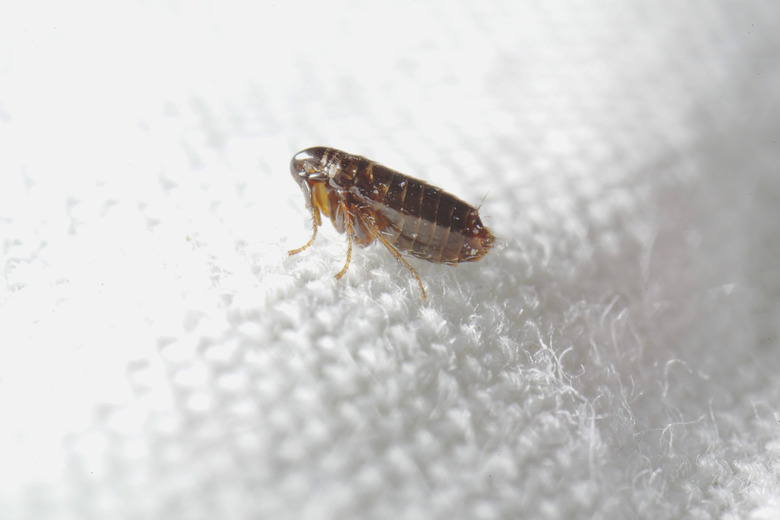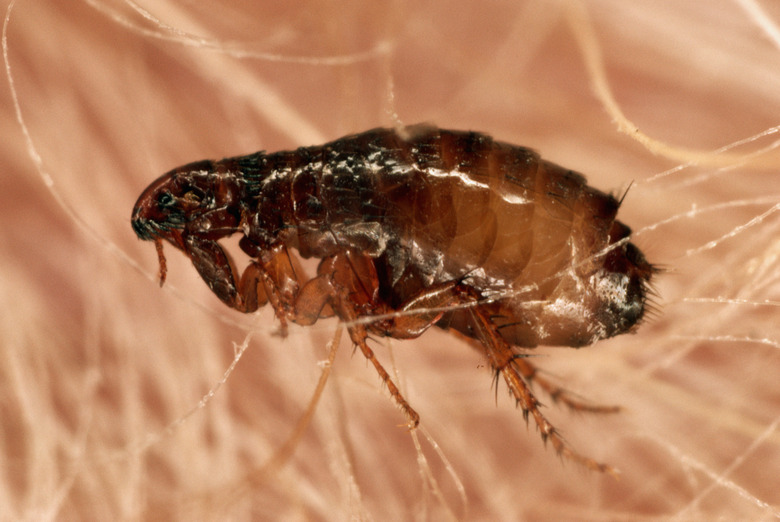How To Get Rid Of Fleas In The House
We may receive a commission on purchases made from links.
If people in the 14th century knew how to get rid of fleas, they might have been able to avoid the Black Death. Rats get most of the blame for spreading bubonic plague, but the actual culprit was a species of flea that infests rats and also attacks humans. Luckily, that species — Xenopsylla cheopis — isn't common in North America, but it isn't completely absent either, and it can infest prairie dogs, rats, and ground squirrels. None of this means, however, that you should be concerned about plague if you experience a flea infestation.
Household fleas, which usually find their way into the house on the bodies of dogs and cats, are not of the species that carries plague, but they are capable of spreading other diseases, such as typhoid, tapeworms, and cat scratch fever. Plus, flea bites are super irritating, and once you have an infestation, you're likely to get several of them.
It isn't as easy to get rid of fleas as it is to get rid of pests like ants or cockroaches because fleas have a complicated life cycle, and a new infestation can occur even after you've killed all the adults. There's also the small matter that fleas are microscopic and are able to avoid your eradication efforts by hiding in carpeting, upholstery, and bedding — not to mention dog and cat fur. Several DIY flea control methods are available to homeowners, but when you have a serious flea problem, your best bet is to call a pest control company.
What Do Fleas Look Like?
What Do Fleas Look Like?
- Species name: Ctenocephalides canis, Ctenocephalides felis
- Physical characteristics: About 2.5 millimeters in length with dark to reddish-brown hairy bodies and six long legs.
- Wings or wingless? Fleas are wingless, but they can jump long distances.
- Color/species varieties: Both C. canis (dog fleas) and C. felis (cat fleas) have the same coloration, but dog fleas have larger abdomens. Two less common flea species (Oropsylla montana and Xenopsylla cheopis) are similar in appearance but aren't common in North American households. The human flea, Pulex irritans, looks almost identical to the other species. All fleas belong to the order Siphonaptera.
- Life cycle and appearance: The
flea life cycle consists of four stages: eggs, larvae, pupae (cocoons), and
adults. Eggs hatch in three to four days, while the larval and pupal stages
each last three to four weeks. A flea egg is about the size of a grain of sand
(about 0.5 millimeters), and the coloring is similar. Larvae look like tiny worms
(about 2 to 5 millimeters in length) but are difficult to see because they
burrow deep into pet fur or carpeting. Pupae are almost always hidden
under a layer of debris. - How to tell fleas from ticks: Both fleas and ticks
are microscopic biting insects, but if they were larger, the
differences between them would be obvious. Ticks are arachnids, so they
have eight legs, while fleas have only six. Ticks are solitary creatures, and
once they start feeding, they stay in the same place and grow
progressively larger as they feed. Fleas congregate, so when you see
one, there are many others around, and they don't remain in one place,
preferring to bite and quickly move on.
How to Get Rid of Fleas
How to Get Rid of Fleas
Once you spot one flea crawling on the armrest of the sofa or you get a flea bite, you know you have an infestation because fleas don't live in isolation. Fleas have an aptitude for hiding, so it won't do much good to focus on killing the ones you can find. Eradication efforts have to be far-reaching, but they will be aided by the fact that fleas prefer to hide in soft, furry, or fibrous materials, so if you have tile floors or walls, you probably don't have to waste much effort cleaning them. This is not so for hardwood or laminate floors, though, because gaps between flooring boards as well as crevices behind baseboards are a favorite refuge for fleas as well as bedbugs.
Deep Clean Soft, Fuzzy Items
The rooms in your house that are most attractive to fleas are the ones with plenty of soft, fuzzy places to hide, such as the bedrooms and living room. If you have a flea problem in any of these rooms, part of the deep cleaning you need to do is to remove all loose rugs and carpeting and wash them. Bring upholstered chairs outside, clean them with a vacuum, and then apply a flea spray.
Consider Fogging
Although it's a drastic measure, you should consider fogging the room with flea foggers. You can use a fogger in other parts of the house as well but check the label before using one in the kitchen to make sure it's safe for use around food.
When to Hire a Pro
When to Hire a Pro
If you still have a flea problem after completing an extensive eradication program, it's probably time to call in the cavalry in the form of an exterminator. A pro will use the same strategies you did, including an insecticide to kill adults and an insect growth regulator, but pros have stronger formulations and the knowledge of how to use them effectively both indoors and around the perimeter of the house. Most companies do two treatments separated by seven to 14 days to kill the insects that emerge from pupae during that period.
The average cost for flea extermination is $270, but the treatment could cost as little as $75 or as much as $400 depending on the size of your house and the extent of the infestation.
Getting Rid of Fleas Naturally
Getting Rid of Fleas Naturally
Besides the many commercial products that kill fleas outright, homeowners have several options for repelling the insects. Killing them is the most effective means of control, though, and if you don't want to do that with chemicals you don't understand, you can do it with more familiar ones. For example, instead of spraying your carpets with flea spray prior to vacuuming, you can dust it with table salt or baking soda, which dries out their exoskeleton, or with diatomaceous earth (DE), which lacerates their body. For safety, use food-grade DE and wear a respirator when dusting it.
You can also make a flea trap consisting of a bowl full of hot water mixed with dish soap. The water attracts thirsty fleas, which get trapped in the soapy water and die. To make this method work, you have to set out a new bowl every day, preferably at night. You can also spray infested carpeting and furniture with a spray made by adding a thinly sliced lemon to a pint of water, bringing the solution to a boil, and letting the solution sit overnight before using it.
To repel fleas, plant pennyroyal, lavender, chrysanthemums, or peppermint around the perimeter of your home. Fleas hate the oils in these plants and will stay away. You can also make a flea repellent by grinding rosemary, rue, wormwood, peppermint, and fennel to a powder in a pestle and sprinkling this on your carpets and furniture.
How Quickly Can You Get Rid of Fleas?
How Quickly Can You Get Rid of Fleas?
It will take about a month to get rid of fleas owing to their complex life cycle. A single female can lay as many as 1,000 eggs, and they take three to four days to hatch into larvae, which eventually form cocoons and pupate, which is a process that takes three to four weeks. Flea eggs and cocoons are generally impervious to insecticides, so treatment has to be repeated to take care of the new adults when they emerge. One way to speed up the eradication is to spray infested areas with an insect growth regulator, which prevents the flea larvae from growing into adults, but you still need to vacuum and clean regularly to remove the immature insects.
How Fleas Get In Your House
How Fleas Get In Your House
Fleas get into homes primarily on the bodies of pets, so pet bedding should be examined often for signs of the insects, including flea dirt or droppings, which looks like black, pepperlike specks. They can also travel in on the bodies of invading rodents, and because they can jump as far as 13 inches, people can also bring them in on their clothes. Because eggs take three days to hatch and pupae take about 14 days to gestate, it takes almost three weeks from initial incursion to full-fledged infestation.
You want to get rid of fleas well before new adults emerge from the pupae because the flea population increases exponentially after that, considering that each new female can lay 1,000 more eggs. Once established in the warmth indoors, fleas are a year-round problem.
How to Prevent Fleas
How to Prevent Fleas
The best way to handle a flea infestation is to prevent fleas from getting in your house in the first place. Since most fleas enter the home on the body of pets, you should start with your four-footed friends. Give your dog or cat a flea collar or treat your pet regularly with an anti-flea treatment, such as Frontline. Bathe your pet as frequently as is practical and comb the fur with a flea comb. To prevent fleas from jumping on your pets, trim grass and trees in your yard and bring your pet's food in at night to prevent feral animals from visiting and bringing fleas with them.
If you see a flea on your pet, act immediately. Wash your pet with a shampoo that kills fleas and repeat the treatment at three-day intervals to kill newly hatched eggs. You can also remove fleas by combing your pet's fur with a flea comb and dipping the comb frequently in soapy water to kill the fleas. In addition to vacuuming the carpeting and upholstery and emptying the vacuum bag outside, spray it with a flea spray to kill fleas that the vacuum cleaner doesn't get.
Do Fleas Spread Disease?
Do Fleas Spread Disease?
For the most part, fleas are more bothersome than they are dangerous. Flea bites are irritating, with the area around the bite often becoming red and itchy, and sensitive people can suffer allergic reactions, but in most cases, the irritation disappears, although it takes longer to do so than a mosquito bite. Rare severe allergic reactions, characterized by shortness of breath, dizziness, and chest pains, require immediate medical attention. Less severe allergic reactions include rashes and swelling and can often be treated with ice packs, alcohol, witch hazel, tea tree oil, aloe vera, or even used tea bags.
It is possible for fleas to carry more serious diseases. Cat fleas, which are the ones most commonly found in North American homes, can carry typhus and cat scratch disease. Dog fleas, which are named for the way they look, not because they are found on dogs, can carry tapeworms, but you usually have to swallow one of the fleas to be infected. Plague is the most serious disease transmitted by fleas, but since the flea that carries it infects feral animals, like ground squirrels and rats, the disease isn't a major concern for people living in cities. Most plague infections occur in rural areas in the Western United States.
References
- Centers for Disease Control and Prevention: Frequently Asked Questions (FAQ) About Plague
- Healthy Pets: 10 Ways to Prevent Fleas from Entering Your Home
- HomeAdvisor: How Much Does It Cost To Hire A Flea Exterminator?
- Ehrlich: Top 8 Flea Home Remedies
- MedicineNet: Flea Bites In Humans Symptoms, and Treatment
- Centers for Disease Control and Prevention: Fleaborne Diseases of the United States
- All-American Pest Control: How Did I Get Fleas When I Don't Have Pets?




